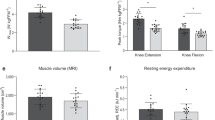Abstract
The results of the present study indicate that the density of the β-adrenergic receptors in the skeletal muscle does not decline with age, despite declines in oxidative capacity both in the skeletal muscle and whole body oxygen consumption. When young rats and old rats of equal body weight trained daily at the same duration and speed for 6 months on the treadmill, skeletal muscle of young and old rats reached the same aerobic capacity. The young demonstrated a significant rise in Bmax of the β receptors, while the old rats did not change their density of receptors. When both young and old rats had the contractile activity of their skeletal muscle raised to the same level through chronic tonic electrical stimulation, the aerobic capacity and β receptor density rose to the same levels in the skeletal muscle. Thus, the contraction-dependent pathway in the senescent muscle appears to function normally given a maximal chronic stimulus via electrical stimulation. These data indicate that the relationship between oxidative capacity, β-adrenergic receptor properties, exercise training, and aging does not appear to be readily explicable by a single unifying mechanism, but probably resides in the interaction of age with a differential responsiveness of the β-adrenergic and/or contraction dependent pathway for stimulation of aerobic capacity in the aging skeletal muscle.
Similar content being viewed by others
References
Goodrick C., Ingram D., Reynolds M., Freeman J., Cider N.: Differential effects of intermittent feeding and voluntary running on body weight and life span in adult rats. J. Gerontol. 38: 36–45, 1983.
Yu B.P., Masoro E.J., McMahan C.A.: Nutritional influences on aging of Fischer 344 rats: I. Physical, metabolic, and longevity characteristics. J. Gerontol. 40: 657–670, 1985.
Cartee G.D., Farrar R.P.: Muscle respiratory capacity and VO2max in identically trained young and old rats. J. Appl. Physiol. 63: 257–261, 1987.
Cartee G.D., Farrar R.P.: Glycogen training induces glycogen sparing during exercise by old rats. J. Appl. Physiol. 64: 259–265, 1988.
Farrar R.P., Martin T.P., Ardies C.M.: The interaction of aging and endurance exercise upon the mitochondrial function of skeletal muscle. J. Gerontol. 36: 642–647, 1981.
Heath G.W., Hagberg J.M., Ehsani A.A., Holloszy J.O.: A physiological comparison of young and older endurance trained adults. J. Appl. Physiol. Respir. Environ. Exercise Physiol. 51: 634–640, 1981.
Williams R.S., Caron M.G., Daniel K.: Skeletal muscle beta-adrenergic receptors: variations due to fiber type and training. Am. J. Physiol. 246: E160–E167, 1984.
Kraus W.E., Bernard T.S., Williams R.S.: Interactions between sustained activity on beta-adrenergic receptors in regulation of gene expression in skeletal muscles. Am. J. Physiol. 256: C506–C514, 1989.
Williams R.S., Salmons S., Newsholme E.A., Kauffman R.E., Mellor J.: Regulation of nuclear and mitochondrial gene expression by contractile activity in skeletal muscle. J. Biol. Chem. 261: 376–380, 1986.
Martin W.H., Coggan A.R., Spina R.J., Saffitz J.E.: Effects of fiber type and training on β-adrenoceptor density in human skeletal muscle. Am. J. Physiol. 20: E736–742, 1989.
Abrass I.B., Davis J.L., Scarpace P.J.: Isoproternol responsiveness and myocardial β-adrenergic receptors in young and old rats. J. Gerontol. 37: 156–160, 1982.
Scarpace P.J., Abrass I.B.: Beta-adrenergic agonist-mediated desentization in senescent rats. Mech. Ageing Dev. 35: 255–264, 1986
Greenberg L.H., Weiss B.: Beta-adrenergic receptors in aged rat brain: reduced number and capacity of pineal gland to develop supersensitivity. Science 201: 61–63, 1978.
Dax E.M.: Age-related changes in membrane receptor interactions. Endocrinol. Metab. Clin. 16: 947–963, 1987.
Hansford R.G., Castro F.: Age-linked changes in the activity of enzymes of the tricarboxylate cycle and lipid oxidation, and of carnitine content, in muscles of the rat. Mech. Ageing Dev. 19: 191–201, 1982.
Walters T.J., Sweeney H.L., Farrar R.P.: Influence of electrical stimulation on a fast-twitch muscle in aging rats. J. Appl. Physiol. 71: 1921–1928, 1991.
Westgaard R.S., Lomo T.: Control of contractile properties within adaptive ranges of patterns of impulse activity in the rat. J. Neurosci. 8: 4415–4426, 1988.
Brooks G.A., White T.P.: Determination of metabolic and heart rate responses to rats to treadmill exercise. J. Appl. Physiol. 45: 1009–1015, 1978.
Fell R.D., Lizzo F.H., Cervoni P., Crandall D.L.: Effect of contractile activity on rat skeletal muscle beta-adrenoceptor properties. Proc. Soc. Exp. Biol. Med. 180: 527–532, 1985.
Scatchard G.: The attractions of proteins for small molecules and ions. Ann. N.Y. Acad. Sci. 51: 660–672, 1949.
Bradford M.: A rapid and sensitive method for the quantita-tion of microgram quantities of protein utilizing the principle of protein-dye binding. Anal. Biochem. 72: 248–254, 1976.
Srere P.A.: Citrate synthase. In: Methods in Enzymology. Academic Press, New York, 13: 3–5, 1969.
Buckenmeyer P.J., Goldfarb A.H., Partilla J.S., Pineyro M.A., Dax E.M.: Endurance training, not acute exercise, differentially alters β-receptors and cyclase in skeletal fiber types. Am. J. Physiol. 9: E71–77, 1990.
Martin W.H., Murphee S.S., Saffitz J.E.: β-adrenergic receptor distribution among fiber types and resistance arterioles of
Author information
Authors and Affiliations
Rights and permissions
About this article
Cite this article
Farrar, R.P., Monnin, K., Fordyce, D.E. et al. Uncoupling of changes in skeletal muscle β-adrenergic receptor density and aerobic capacity during the aging process. Aging Clin Exp Res 9, 153–158 (1997). https://doi.org/10.1007/BF03340141
Received:
Accepted:
Published:
Issue Date:
DOI: https://doi.org/10.1007/BF03340141




